
Abhay Charanaravinda Bhaktivedanta Swami or Srila Prabhupada, born Abhay Charan De, was an Indian spiritual teacher and the founder-acharya (preceptor) of the International Society for Krishna Consciousness (ISKCON), commonly known as the "Hare Krishna Movement". Members of the ISKCON movement view Bhaktivedanta Swami as a representative and messenger of Krishna Chaitanya.

The International Society for Krishna Consciousness (ISKCON), known colloquially as the Hare Krishna movement or Hare Krishnas, is a Gaudiya Vaishnava religious organisation. ISKCON was founded in 1966 in New York City by A. C. Bhaktivedanta Swami Prabhupada. Its core beliefs are based on the Vedic scriptures, particularly the Bhagavad Gita and the Bhagavata Purana, and the Gaudiya Vaishnava tradition, which has had adherents in India since the late 15th century and American and European devotees since the early 1900s.
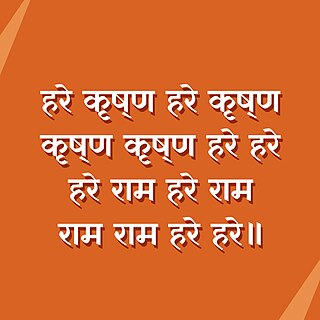
The Hare Krishna mantra, also referred to reverentially as the Mahā-mantra, is a 16-word Vaishnava mantra which is mentioned in the Kali-Santarana Upanishad and which from the 15th century rose to importance in the Bhakti movement following the teachings of Chaitanya Mahaprabhu. This mantra is composed of two Sanskrit names of the Supreme Being, "Krishna" and "Rama".
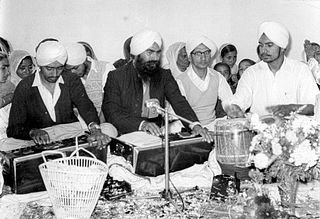
Kirtan is a Sanskrit word that means "narrating, reciting, telling, describing" of an idea or story, specifically in Indian religions. It also refers to a genre of religious performance arts, connoting a musical form of narration or shared recitation, particularly of spiritual or religious ideas, native to the Indian subcontinent.

Gaudiya Vaishnavism, also known as Bengali Vaishnavism, Chaitanya Vaishnavism or the Gaudiya Vaishnava tradition, is a Vaishnava Hindu religious movement inspired by Chaitanya Mahaprabhu (1486–1534) in India. "Gaudiya" refers to the Gauda region of Bengal, with Vaishnavism meaning "the worship of Vishnu". Its theological basis is primarily that of the Bhagavad Gita and Bhagavata Purana, as interpreted by early followers of Chaitanya, such as Sanatana Goswami, Rupa Goswami, Jiva Goswami, Gopala Bhatta Goswami and others.

The Bhagavad-Gītā As It Is is a translation and commentary of the Bhagavad Gita by A. C. Bhaktivedanta Swami Prabhupada, founder of the International Society for Krishna Consciousness (ISKCON), commonly known as the Hare Krishna movement. The Bhagavad Gita emphasizes a path of devotion toward the personal God, Krishna. It was first published in 1968 in English by Macmillan Publishers, and is now available in nearly sixty languages. It is primarily promoted and distributed by followers of ISKCON. The Bhagavad-Gītā As It Is is considered by adherents of the ISKCON movement and many Vedic scholars to be one of the finest literary works of Vaishnavism translated into English.
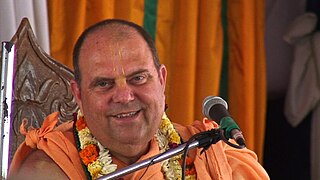
Jayapataka Swami ; born 9 April 1949 in Milwaukee, Wisconsin) is a Vaishnava swami and a religious leader for the International Society for Krishna Consciousness (ISKCON). He is a senior disciple of A. C. Bhaktivedanta Swami Prabhupada. Presently he is one of the initiating spiritual masters,, a member of the Governing Body Commission (GBC), and is a divisional trustee for the Bhaktivedanta Book Trust (BBT).

Satsvarupa das Goswami is a senior disciple of Bhaktivedanta Swami, who founded the International Society for Krishna Consciousness (ISKCON), better known in the West as the Hare Krishna movement. Serving as a writer, poet, and artist, Satsvarupa dasa Goswami is the author of Bhaktivedanta Swami's authorized biography,Srila Prabhupada-lilamrta. After His Divine Grace A. C. Bhaktivedanta Swami Prabhupada's death, Satsvarupa dasa Goswami was one of the eleven disciples selected to initiate future disciples on His Divine Grace’s behalf. Satsvarupa dasa Goswami,, is one of the first few Westerners ordained by Bhaktivedanta Swami in September 1966. He has been since established as a prolific Vaishnava writer and poet. While traveling, lecturing on Krishna consciousness, and instructing disciples worldwide, he published over hundred books including poems, memoirs, essays, novels, and studies based on the Vaishnava scriptures. In his later years he created hundreds of paintings, drawings, and sculptures that attempt to capture and express his perspective on the culture of Krishna consciousness.
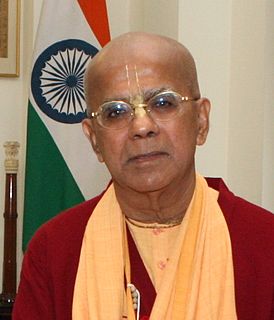
Gopal Krishna Goswami is a religious leader within the International Society for Krishna Consciousness. He was the first Indian disciple of A.C. Bhaktivedanta Swami Prabhupada to be initiated after the establishment of ISKCON. Gopal Krishna Goswami is currently a member of the Governing Body Commission and an initiating guru within the movement.

Kirtanananda Swami, also known as Bhaktipada, was a Gaudiya Vaishnava guru and the co-founder of New Vrindaban, a Hare Krishna community in Marshall County, West Virginia, where he served as spiritual leader from 1968 until 1994.

Ranchor Prime is a British author, researcher on Hindu environmental issues, and a Hindu religious scholar. Ranchor Prime is best known for his books on Hinduism and ecology. He is a disciple of A. C. Bhaktivedanta Swami Prabhupada. Ranchor Prime has translated the Bhagavad Gita into English. It was published with illustrations by B. G. Sharma as The Illustrated Bhagavad Gita: A New Translation with Commentary.

Steven J. Rosen, also known as Satyaraja Dasa, is an American author. He is the founding editor of The Journal of Vaishnava Studies and an associate editor of Back to Godhead, the magazine of the Hare Krishna movement. He has authored more than 30 books on Vaishnavism and related subjects, including Black Lotus: The Spiritual Journey of an Urban Mystic (2007), which is the life story of Bhakti Tirtha Swami.
This article discusses the London Radha Krishna Temple, which has been the headquarters of the International Society for Krishna Consciousness (ISKCON) in the United Kingdom since the late 1960s. It was founded in Bury Place, Bloomsbury, by six devotees from San Francisco's Radha Krishna Temple, who were sent by ISKCON leader A.C. Bhaktivedanta Swami Prabhupada to establish a UK branch of the movement in 1968. The Temple came to prominence through George Harrison of the Beatles publicly aligning himself with Krishna consciousness. Among the six initial representatives in London, devotees Mukunda, Shyamsundar and Malati all went on to hold senior positions in the rapidly growing ISKCON organisation.
Indradyumna Swami is an ISKCON Guru and a sannyasi for the International Society for Krishna Consciousness. He is a disciple of A. C. Bhaktivedanta Swami Prabhupada and is known for his traveling and preaching activities around the world, especially in Poland. Indradyumna Swami shares his experiences and realizations as a traveling monk in his journal The Diary of a Traveling Monk.

Vishnujana Swami, born Mark Stephen D'Atillo, was a disciple of A. C. Bhaktivedanta Swami Prabhupada, and a sannyasi within the International Society for Krishna Consciousness. Despite his mysterious disappearance in 1976, he continues to be regarded as a saintly figure within ISKCON. His legend lives on through recordings of his celebrated singing of the Hare Krishna mantra and through his unmatched success as a preacher in the early days of the movement.

Jayatirtha Das, formerly Jayatirtha Swami was one of the leading disciples of A. C. Bhaktivedanta Swami Prabhupada and a guru within the International Society for Krishna Consciousness. Born James Edward Immel and also known as Vijaya Acharya and Tirthapada, Jayatirtha was appointed a life trustee of the Bhaktivedanta Book Trust by his guru, Prabhupada, who also placed him in the managerial post of the fledgling Spiritual Sky company. Under Jayatirtha's able management the company became a multimillion-dollar concern and the Wall Street Journal covered the company's success with a front-page article.
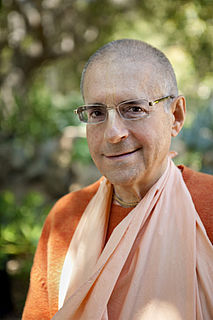
Giriraj Swami is an initiating guru within the International Society for Krishna Consciousness (ISKCON) and one of the leading disciples of A. C. Bhaktivedanta Swami Prabhupada, the founder-acharya of ISKCON.
Hare Krishna views of homosexuality, and especially the view of the International Society for Krishna Consciousness (ISKCON) towards LGBT issues, are similar to their views of heterosexual relationships, i.e. because the living entity is identifying with the body, any attraction based on the desire to gratify the body and its senses is symptomatic of illusion and can be purified by progressively elevating the consciousness. Put simply, both hetero- and homosexual attraction is due to an illusory attachment to the temporary body. Same-sex relations and gender variance have been represented within Hinduism from Vedic times through to the present day, in rituals, law books, mythical narratives, commentaries, paintings, and sculpture. The extent to which these representations embrace or reject homosexuality has been disputed within the religion as well as outside of it.

A ISKCON guru is a person who is permitted to initiate disciples into the International Society for Krishna Consciousness system. The guru system has undergone several changes and reform since its beginnings in the 1960s. Upanayana as a traditional "sacred thread ceremony" of the Gayatri Mantra, commonly known Hindu Samskara, is complemented by Pancaratric mantras of the Gaudiya Vaishnava sampradaya and follows the principal initial nama initiation ceremony, referred to respectively as brahmana diksa and Hari nama diksa.
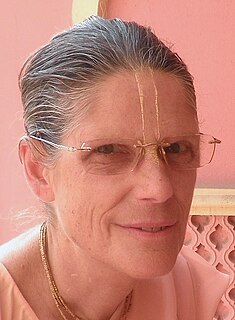
Malati Dasi is a senior spiritual leader of the International Society for Krishna Consciousness (ISKCON). Born in Vallejo, California, she was part of the hippie movement before becoming an initiated disciple of A. C. Bhaktivedanta Swami Prabhupada in 1967. In the same year, she and her husband, Shyamasundar Das, helped Mukunda Das organize the Mantra-Rock Dance, a countercultural musical event held at the Avalon Ballroom in San Francisco; the dance was a fundraiser for ISKCON's first center on the west coast of the US.
















